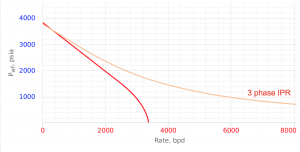Difference between revisions of "3 Phase IPR"
From wiki.pengtools.com
(→Given:) |
(→3 Phase IPR calculation example) |
||
| Line 44: | Line 44: | ||
Following the example problem #21, page 33 <ref name=KermitBrown1984 />: | Following the example problem #21, page 33 <ref name=KermitBrown1984 />: | ||
===Given:=== | ===Given:=== | ||
| − | :<math>P_r</math>=2550 psi | + | :<math>P_r</math> = 2550 psi |
| − | :<math>P_b</math>=2100 psi | + | :<math>P_b</math> = 2100 psi |
Test data: | Test data: | ||
| − | :<math>P_{wf}</math>=2300 psi | + | :<math>P_{wf}</math> = 2300 psi |
| − | :<math>q_t</math>=500 b/d | + | :<math>q_t</math> = 500 b/d |
===Calculate:=== | ===Calculate:=== | ||
Revision as of 09:17, 11 April 2019
Contents
Three-phase Inflow Performance Relationship

3 Phase IPR Curve [1]
3 Phase IPR calculates IPR curve for oil wells producing water at various watercuts.
3 Phase IPR equation was derived by Petrobras based on combination of Vogel's IPR equation for oil flow and constant productivity for water flow [1].
3 Phase IPR curve is determined geometrically from those equations considering the fractional flow of oil and water [1].
Math and Physics
Total flow rate equations:
For Pb < Pwf < Pr
For pressures between reservoir pressure and bubble point pressure:
For PwfG < Pwf < Pb
For pressures between the bubble point pressure and the flowing bottom-hole pressures:
where:
For 0 < Pwf < PwfG
where:
And
3 Phase IPR calculation example
Following the example problem #21, page 33 [1]:
Given:
 = 2550 psi
= 2550 psi = 2100 psi
= 2100 psi
Test data:
 = 2300 psi
= 2300 psi = 500 b/d
= 500 b/d
Calculate:
Determine the 3 Phase IPR curves for Fw=0, 0.25, 0.5, 0.75, and 1.
Solution:
Nomenclature
 = calculation variables
= calculation variables = oil fraction, fraction
= oil fraction, fraction = water fraction, fraction
= water fraction, fraction = productivity index, stb/d/psia
= productivity index, stb/d/psia = pressure, psia
= pressure, psia = flowing rate, stb/d
= flowing rate, stb/d
Subscripts
- b = at bubble point
- max = maximum
- o = oil
- r = reservoir
- t = total
- wf = well flowing bottomhole pressure
- wfG = well flowing bottomhole pressure at point G













